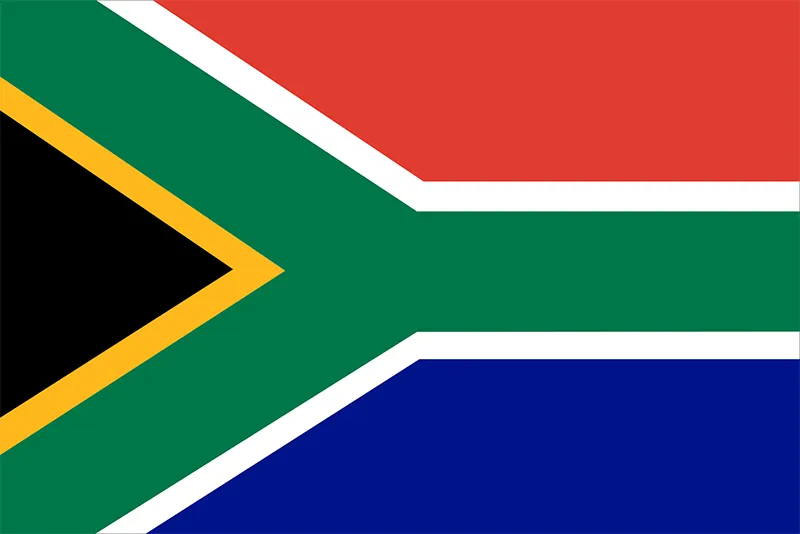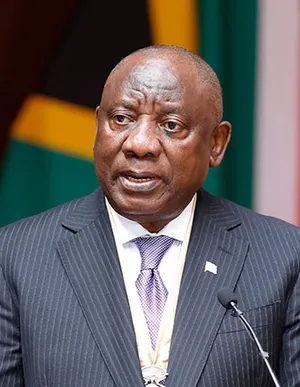Country Name: South Africa
Country Flag:

Indigenous routes: Home to the Cradle of humankind, South Africa’s first inhabitants are the Khoisan, the Khwe and the San. In 1,000 BCE the Bantu tribes migrating from Western to Central Africa during Bantu expansion joined these inhabitants.
Colonial Legacy: In 1652 Dutch and British colonisers dispossessed indigenous peoples of their land, establishing a system of racial hierarchy. The Cape colony was declared in 1806, by the British. The Union of South Africa was later formed in 1910. South Africa was an extension of the colonies controlled by the English monarchy.
Apartheid regime: the National party was formed in 1914 to promote afrikaner interests. It won the 1948 general elections and implemented its systematic racial policies , brutally oppressing people of colour.
Democratic South Africa: In 1994, after the Apartheid system had failed and was met with resistance both internally and externally. The African National Congress (ANC) came under the leadership of Nelson Rolihlahla Mandela.
Cape Town (legislature)
Bloemfontein (Judicial)
Pretoria (Administrative)
Time Zone: UTC+02:00 – Central African Time
Total Area: 1.22 million km²
Position in the world (by total area): 24th
Arable land: 9.89%
Semi-Arid Savannah: The northern interior, dominated by the Kalahari region, features a semi-arid climate. It experiences hot summers with scattered thunderstorms, followed by dry winters with clear skies and cool nights.
Mediterranean Coast: Along the southwestern Cape, a Mediterranean climate prevails, bringing hot, dry summers and mild, wet winters. This region enjoys abundant sunshine and cooling sea breezes in the warmer months.
Subtropical East Coast: The eastern coastline has a humid, subtropical climate with hot, rainy summers and warm, mild winters. This area benefits from moist winds from the Indian Ocean, contributing to lush vegetation.
Continental Highlands: The central plateau, encompassing the Highveld, experiences a temperate climate. Summers are warm and wet, with thunderstorms, while winters are dry and can be crisp, especially at higher altitudes.
South Africa is divided into nine provinces, each with its own unique geography, culture, and economy:
Flooding Threat: Intense rainfalls during the summer months can lead to flash floods, particularly in the coastal regions of KwaZulu-Natal and the Eastern Cape, where rivers often swell rapidly.
Drought’s Hold: The western and central regions, including parts of the Northern Cape, are prone to prolonged droughts. These dry spells impact agriculture, water supply, and local ecosystems.
Fire Season: The dry, windy summers in the Western Cape and other dry areas lead to an increased risk of wildfires. This can be particularly severe in fynbos vegetation, where fires are both natural and frequent.
Landslide Risk: Steep mountainous areas, such as those in Mpumalanga and KwaZulu-Natal, face landslide risks, especially during the rainy season when heavy rains destabilise the soil.
Coastal Storm Surges: Coastal areas along the Indian and Atlantic Oceans, particularly KwaZulu-Natal, are vulnerable to storm surges and coastal erosion during intense storms and cyclones.
South Africa exerts control over a vast maritime territory exceeding 1 million square kilometres. Established by the Maritime Zones Act of 1994, this zone encompasses several key areas. Territorial waters, the closest zone to the coastline, grant South Africa complete control over resources and activities. Beyond this lies the contiguous zone, where South Africa can regulate activities that might impact its security or resources within territorial waters. The exclusive economic zone (EEZ) extends even further, granting South Africa exclusive rights to explore, exploit, conserve, and manage resources like fish, minerals, and oil. The continental shelf, the underwater extension of the continent’s landmass, also falls under South African jurisdiction for resource exploration and exploitation. Finally, the Prince Edward Islands, located roughly 1,000 kilometres southeast of Port Elizabeth, are considered part of this maritime territory.
Power Structure: South Africa is a constitutional democracy with three branches: the legislature, the judiciary, and the executive. This happens across the government tires: the National, Provincial and Local levels. The elected official from the ruling party becomes the president which controls the executive branch of power and governs the country.
Parties: South Africa has a very diverse political scene with more than a 1000 political parties. These are political parties that represent minorities and majorities within the country.
Left – Right Divide: South Africa with many political parties on different sides of the spectrum. The ANC has been labelled centre left with the official opposition party labelled centre right. Signifying smaller differences in the top two largest South African parties.
Allies
Regional Partnerships:
African Union (AU): South Africa is a leading member of the AU, playing a crucial role in peacebuilding and development efforts across the continent.
Southern African Development Community (SADC): As a regional powerhouse, South Africa works closely with SADC countries to foster economic integration and address regional challenges.
Global Partnerships:
BRICS: South Africa is part of the BRICS group (Brazil, Russia, India, China, South Africa), an alliance of emerging economies that collaborate on global economic and political issues.
IBSA: This trilateral partnership with India and Brazil focuses on promoting South-South cooperation and advocating for the interests of developing nations.
Traditional Allies: Countries like the United States, Germany, and the United Kingdom remain important partners for trade, investment, and security cooperation.
Government Type: Parliamentary Constitutional Republic President:
President: Cyril Ramaphosa

(2018-present)
*South Africa currently has a coalition led by the ANC and by extension Cyril Ramaphosa
Elections: Every 5 years
Upcoming national election: April 2029
South-South Cooperation: South Africa emphasises cooperation with developing countries, particularly in Latin America and Africa.
Multilateralism: South Africa is a strong supporter of the United Nations and other international organisations.
Global Leadership: South Africa is a strong voice for Africa and spearheads the African cause.
Size in world: 39th
GDP: $400 Billion USD
GDP per capita: $6,339 USD
Currency: South African Rand (R) ZAR
Dominant Economic Sector: Commerce
Market type: Mixed Economy
Inbound
Outbound
Imports
Exports
Social Landscape
Population: Approximately 60 million
Position: Class distribution
Upper: 4%
Middle: 35%
Lower: 61%
Gini Coefficient:
63 (where 0 = perfect equality and 100 = perfect inequality)
Language
Official languages:
Religion
Dominant religion: Christianity
Other religions: Islam, Hinduism, Judaism, Traditional African Religions